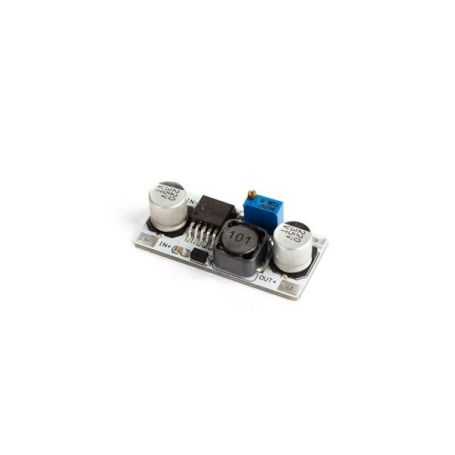DC-DC converter, Step Down 1.25-35V, LM2596S
DC-DC converter, Step Down 1.25-35V, LM2596S
- Input voltage: 3 to 40V
- Output voltage: 1.5V to 35V
- Input current: 2.5A max.
Payments are secured by LyraCollect, a French payment collection company.
It is possible to delivered to your home, to a pick-up point or picked up by appointment at MCHobby
We prepare, pack and ship your orders with great respect and care.
Reduce to an adjustable output voltage from 1.25 to 35V with this pre-assembled LM2596S board
This step-down converter can be used to reduce a higher voltage to a lower voltage. This would help you to produce the control logique voltage from an higher voltage like a battery (eg: producing 5V from a 12V battery used to power up the motors).
The DC/DC converter (switching) offer a very good efficiency. They dissipate less heat than linear regulator, which dissipate more heat.
The characteristics only mention the input current and not the output current! The raison for such omission is simple: greater is difference of voltage between the input and the output and less you will have current available at the output. Usually, bigger is the difference between the input and the output -AND- lower is the efficiency (the raison why you have less current. Eg: with an input voltage of 20V and output voltage of 3.3v will decrease the efficiency to 75% whereas the efficiency is still at 90% with 12V output voltage).
A lower efficiency imply more heat to sink out of the DC/DC switch. As this temperature rising may cause thermal shutdown then you have to limit yourself to a lower output current in order to limit the overheat.
Step-up, Step-Down... what is this?
Step-Up means "increase" whereas Step-Down means "decrease".
Step-up and step-down are the main characteristics of switching DC/DC regulator. A step-up regulator would be able to raise the output voltage higher than the input voltage. A step-down regulator would be able to reduce the output voltage from an higher voltage input.
A Step-up/Step-Down regulator is able to produce the output voltage from an lower or higher input voltage. This last version is great to maintain your project powered as long as possible (eg: when battery voltage is lowering slowly with the time, even under the logic voltage).
Characteristics
- Input voltage: 3.0 to 40V DC
- Output voltage: 1.25 to 35V DC (ajustable)
- Input current: 2.5A max
- Output current: see technical datasheet
- DC/DC switching converter LM2596S
- LM2596 technical datasheet
- Size: 49 x 26 x 12mm






